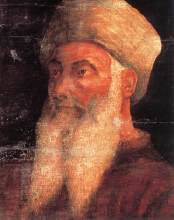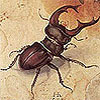|
усднфмхйх
тнрнцпютш
ймхцх Х юркюяш
яхярелю фхбнцн
лхпю Б
хккчярпюжхъу
люярепяйюъ Х
хгдюрекэярбн
|
оЮНКН сВВЕККН
Paolo Ucello
Paolo Uccello
Paolo di Dono [born]

(1397-1475)
оЕПЕИРХ Б юПР-ЦЮКЕПЕЧ Paolo Ucello
Biography
Florentine painter whose work attempted uniquely to reconcile two
distinct artistic styles - the essentially decorative late Gothic and the new
heroic style of the early Renaissance. Probably his most famous paintings are
three panels representing The Rout of San Romano (mid-1450s). His careful and
sophisticated perspective studies are clearly evident in The Flood (1447-48).
By the time Paolo was 10 years old he was already an apprentice in the workshop
of the sculptor Lorenzo Ghiberti, who was then at work on what became one of the
supreme masterpieces of the history of art - the bronze doors for the Baptistery
of the Florence cathedral, which consisted of 28 panels illustrating New
Testament scenes of the life of Christ. In 1414 Uccello joined the confraternity
of painters (Compagnia di S. Luca), and in the following year he became a member
of the Arte dei Medici e degli Speziali, the official guild to which painters
belonged. Though Uccello must by then have been established as an independent
painter, nothing of his work from this time remains, and there is no definite
indication of his early training as a painter, except that he was a member of
the workshop of Ghiberti, where many of the outstanding artists of the time were
trained.
Uccello's earliest, and now badly damaged, frescoes are in the Chiostro Verde
(the Green Cloister, so called because of the green cast of the frescoes that
covered its walls) of Santa Maria Novella; they represent episodes from the
creation. These frescoes, marked with a pervasive concern for elegant linear
forms and insistent, stylized patterning of landscape features, are consistent
with the late Gothic tradition that was still predominant at the beginning of
the 15th century in Florentine studios and have given rise to the hope that
Uccello's artistic origins may yet be found in some of these studios.
From 1425 to 1431, Uccello worked in Venice as a master mosaicist. All his work
in Venice has been lost, and plans to reconstruct it have been unsuccessful.
Uccello may have been induced to return to Florence by the commission for a
series of frescoes in the cloister of San Miniato al Monte depicting scenes from
monastic legends. While the figural formulations of these ruinous frescoes still
closely approximate the Santa Maria Novella cycle, there is also a fascination
with the novel perspective schemes that had appeared in Florence during
Uccello's Venetian sojourn and with a simplified and more monumental treatment
of forms deriving from the recent sculpture of Donatello and Nanni di Banco.
In 1436 in the Florence cathedral, Uccello completed a monochrome fresco of an
equestrian monument to Sir John Hawkwood, an English mercenary who had commanded
Florentine troops at the end of the 14th century. In the Hawkwood fresco, a
single-point perspective scheme, a fully sculptural treatment of the horse and
rider, and a sense of controlled potential energy within the figure all indicate
Uccello's desire to assimilate the new style of the Renaissance that had
blossomed in Florence since his birth. Following the Hawkwood monument, in 1443
Uccello completed four heads of prophets around a colossal clock on the interior
of the west faГade of the cathedral; between 1443 and 1445 he contributed the
designs for two stained-glass windows in the cupola.
After a brief trip to Padua in 1447, Uccello returned to the Chiostro Verde of
Santa Maria Novella. In a fresco illustrating the Flood and the recession,
Uccello presented two separate scenes united by a rapidly receding perspective
scheme that reflected the influence of Donatello's contemporary reliefs in
Padua. Human forms in The Flood, especially the nudes, were reminiscent of
figures in Masaccio's frescoes in the Brancacci Chapel (c. 1425), perhaps the
most influential of all paintings of the early Renaissance, but the explosion of
details throughout the narrative again suggests Uccello's Gothic training. More
than any other painting by Uccello, The Flood indicates the difficulties that he
and his contemporaries faced in attempting to graft the rapidly developing
heroic style of the Renaissance onto an older, more decorative mode of painting.
Perhaps Uccello's most famous paintings are three panels representing the battle
of San Romano, now in the Louvre, Paris; the National Gallery, London; and the
Uffizi, Florence. These panels represent the victory in 1432 of Florentine
forces under Niccolò da Tolentino over the troops of their arch rival, Siena.
There are Renaissance elements, such as a sculpturesque treatment of forms and
fragments of a broken perspective scheme in this work, but the bright handling
of colour and the elaborate decorative patterns of the figures and landscape are
indebted to the Gothic style, which continued to be used through the 15th
century in Florence to enrich the environments of the new princes of the day,
such as the Medici, who acquired all three of the panels representing the rout
of San Romano.
Uccello is justly famous for his careful and sophisticated perspective studies,
most clearly visible in The Flood, in the underdrawing (sinopia) for his last
fresco, The Nativity, formerly in S. Martino della Scala in Florence, and in
three drawings universally attributed to him that are now in the Uffizi. These
drawings indicate a meticulous, analytic mind, keenly interested in the
application of scientific laws to the reconstruction of objects in a
three-dimensional space. In these studies he was probably assisted by a noted
mathematician, Paolo Toscanelli. Uccello's perspective studies were to influence
the Renaissance art treatises of artists such as Piero della Francesca, Leonardo
da Vinci, and Albrecht DЭrer. Uccello apparently led an increasingly reclusive
existence during his last years.
Assessment
Uccello was long thought to be significant primarily for his role in
establishing new means of rendering perspective that became a major component of
the Renaissance style. The 16th-century biographer Giorgio Vasari said that
Uccello was "intoxicated" by perspective. Later historians found the unique
charm and decorative genius evinced by his compositions to be an even more
important contribution. Though in ruinous condition, they indicate the immense
difficulties faced by artists of his time in taking advantage of new
developments without giving up the best in traditional art.
|
оЕПЕИРХ Б юПР-ЦЮКЕПЕЧ Paolo Ucello
яЯШКЙХ -
Links
http://en.wikipedia.org/wiki/Paolo_Uccello
|
|
